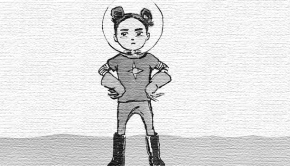The fightback against gendered toys
Parenting tips with…
Kira Cochrane | The Guardian
Do all girls really want to play with dolls and tea sets? Do all boys want guns and trucks? Of course not. Then why are toymakers so aggressive in marketing these stereotypes?
Three years ago, while she was on maternity leave, Ros Ball and her partner, James, began a diary of their children’s lives. Their daughter Josie was three and their son Clem three months old. They wanted to record the moments when their children were made aware of gender stereotypes; when they were directed towards a view of the world in which girls and boys inhabit separate, rigid spheres of pink and blue – the first sphere passive, pretty and gentle, the second aggressive, active and strong.
The results were tweeted under the title Baby Gender Diary, and Ball, a broadcast journalist who lives in London, couldn’t believe how much there was to write about. On the first day, they went to a pantomime with a toy stall, where Josie’s older male cousins directed her straight towards the sort of item supposedly beloved of small girls: a fluffy pink tiara. One of these boys then chose a flashing torch, in pink, for himself, to which the stallholder responded: “Shall I get you that in blue?” The boy, aged about five, readily agreed to the swap.
The next day, when Josie was shown around the nursery she would be attending, a table covered in cars was described specifically as “the boys’ corner”. Not long afterwards, Ball saw two different children’s TV programmes, in quick succession, featuring male characters who were deeply embarrassed to be seen wearing the colour pink.
Ball was inspired to start the project after reading There’s a Good Girl by the German lawyer and writer Marianne Grabrucker. The book was an international bestseller when first published in the 80s, and charts the gender stereotypes Grabrucker’s daughter Anneli was subject to, starting from her birth in August 1981. At the time Grabrucker was keeping the diary, these stereotypes were under attack, and seemed likely to weaken in future or even sputter out entirely. Second-wave feminists of the 60s and 70s had analysed gender roles and kickstarted a trend for non-sexist parenting, built on a determination to bring up children free to embrace what interested them – be it maths, construction and cars for girls, or fashion, dolls and cookery for boys.
In the years since, there has been obvious progress towards gender equality in the adult world. Many more women have moved into the workplace and public life, many men have taken on a greater share of domestic chores, and gay and transgender people have fought strongly, often successfully, for greater rights and visibility. Yet when it comes to the world of children – the toys they play with and the clothes they wear – stereotypes have never been so defined, or rigidly enforced. Pink and blue have triumphed in the toy market, and there are often serious social penalties for children who breach the divide. The rise of highly gendered toys is a result of capitalism, but it also suggests a deep, subconscious unease with the advances of the past few decades.
Over the past few years, people across the world have begun questioning this culture. In the US, for instance, a high-school student called Antonia Ayres-Brown wrote this week about a campaign she has pursued since 2008, when she was 11, to stop McDonald’s handing out their Happy Meal toys on the basis of gender. She recently received a letter from the company’s chief diversity officer, stating: “It is McDonald’s intention and goal that each customer who desires a Happy Meal toy be provided the toy of his or her choice, without any classification of the toy as a ‘boy’ or ‘girl’ toy.”








